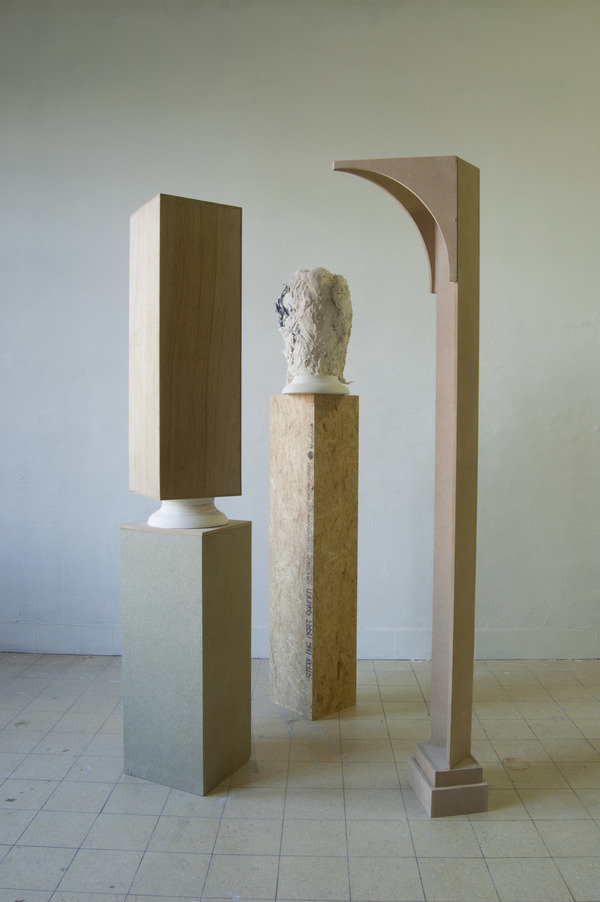The Brancusi Effect
dal 10/6/2014 al 20/9/2014
Segnalato da
Saâdane Afif
Wilfrid Almendra
Nina Beier
Anca Benera & Arnold Estefan
Constantin Brancusi
André Cadere
Koenraad Dedobbeleer
Alessio delli Castelli
Thea Djordjadze
Paulien Föllings
Isa Genzken
Konstantin Grcic
Jürgen Mayer H.
Sofia Hultén
Haraldur Jónsson
An Te Liu
Josephine Meckseper
Ute Müller
Anca Munteanu Rimnic
Shahryar Nashat
Olaf Nicolai
Odilon Pain
Luiz Roque
Rudi Stanzel
Vanessa Joan Müller
Nicolaus Schafhausen
10/6/2014
The Brancusi Effect
Kunsthalle Wien Project Space, Wien
The exhibition presents original photographic material together with selected positions of contemporary art that reference Brancusi, and so creates an imposing spatial installation comprising various sculptures that reflect the recent currency of the sculptural within contemporary art.

The Romanian sculptor Constantin Brancusi (1876–1957) is numbered among the
20th century’s most influential artists. With his considerations of the way that pedestal
and presented work relate to each other he launched a reorientation of the relationship
between object, viewer and space. This had a decisive influence on minimal art and
the aesthetic of the installation as a whole.
Moreover, Brancusi’s work is seen as the initial point of a reflection on the artwork’s
historical and institutional positioning. The exhibition The Brancusi Effect takes
this potential into account as well as the strongly documentary aspect implicit in
Brancusi’s artistic approach, which was expressed in countless photographic images
of installations taken in his studio. The exhibition presents original photographic
material together with selected positions of contemporary art that reference Brancusi,
and so creates an imposing spatial installation comprising various sculptures that
reflect the recent currency of the sculptural within contemporary art.
Photographs of Brancusi in his studio in the Impasse Rosin in Paris, showcase how
he used installative arrangements to present his works as a spatially unified work of
art. Brancusi moreover also personally photographed individual works, in order to
translate the special aura of his sculptures into the medium of photography. The loan
from the Kunsthaus Zurich provides a fascinating insight into the thinking and the
production methods of this artist, who, between tradition and modernity, created a
work of singularity within the European avant-garde.
Further insight into the work of Brancusi can be drawn from the work Les 58
numéros flotents, an unwilling collaborative work between Brancusi, the Japanese
photographer Soichi Sunami and the Italian publisher Giovanni Scheiwiller,
directed both formally and conceptually by Marcel Duchamp’s invisible hand. The
five photographs conclude the operation started by Duchamp on Brancusi’s work
which began with the installation at Brummer Gallery in 1933 and which completely
overturned the reading of the work and paved the way for its future, American
perception. Alessio delli Castelli’s work on these objects, oscillating between
documents and works of art, is presented in the catalogue alongside Paola Mola’s
original studies on the subject.
The contemporary positions in the exhibition are characterised by an enormous
heterogeneity, but share an interest in the relationship between work and pedestal,
work and space and the modular principle, exemplified in one of Brancusi’s
most famous works Endless Column. The combination of different materials, the
coexistence of different volumes and the dissolution of the idea of a supporting
pedestal in favour of an integral sculptural component, also characterise the selected
works by international artists.
An Te Liu transforms Styrofoam parts from transport packaging of hi-fi equipment or
household appliances into elegant modular bronze sculptures. In Ok Ok Ok Ok Ok,
Sofia Hultén, spans a floor-to-ceiling filigree column out of old car jacks. The works
by Koenraad Dedobbeleer muddle up the perception of the relationship between
objects and their appearance; the works appear both as sculpture and as pedestal
of a sculpture. Ute Müller in turn combines found materials with organically shaped
sculptures into dense sculptural arrangements.
The exciting interior and exterior insights arising out of this coexistence of different
sculptural positions, in the glass pavilion of Kunsthalle Wien Karlsplatz, in essence
once more serve to emphasize the currency of Brancusi.
Artists: Saâdane Afif, Wilfrid Almendra, Nina Beier, Anca Benera & Arnold Estefan,
Constantin Brancusi, André Cadere, Koenraad Dedobbeleer, Alessio delli Castelli,
Thea Djordjadze, Paulien Föllings, Isa Genzken, Konstantin Grcic, Jürgen Mayer H.,
Sofia Hultén, Haraldur Jónsson, An Te Liu, Josephine Meckseper, Ute Müller, Anca
Munteanu Rimnic, Shahryar Nashat, Olaf Nicolai, Odilon Pain, Luiz Roque, Rudi
Stanzel
Curators: Vanessa Joan Müller, Nicolaus Schafhausen
A publication with texts by Paola Mola and Alessio delli Castelli is being produced to
accompany the exhibition (published by Sternberg Press, in collaboration with Dan
Gunn).
Image: Paulien Föllings, Structure with bird, 2012
Press
Katharina Murschetz
+43 (0) 1 5 21 89 - 1221
katharina.murschetz@kunsthallewien.at
Stefanie Obermeir
+43 (0) 1 5 21 89 - 1224
presse@kunsthallewien.at
Program
Press conference: Wednesday, June 11, 2014, 10 am
Opening of the exhibition The Brancusi Effect
Wed June 11, 7 pm
Guided tours
every Sunday, 12 pm
Curator’s Tours
Thu July 10, 6 pm: Vanessa Joan Müller (Head of Dramaturgie)
Thu July 17, 6 pm: Luca Lo Pinto (Curator), (in English)
Thu July 31, 6 pm: Anne Faucheret (Curator)
Thu August 7, 6 pm: Nicolaus Schafhausen (Director)
Thu August 14, 6 pm: Vivien Trommer (Curatorial Assistent)
Thu August 21, 6 pm: Andrea Fichtel (Curatorial Assistent)
Thu August 28, 6 pm: Lucas Gehrmann (Curator)
Thu September 11, 6 pm: Martin Walkner (Curator)
Artist talk with Haraldur Jónsson
Fri June 13, 6 pm
Lecture: Vanessa Joan Müller Vorrichtungen des Zeigens: Vom Sockel zum Raum
Tue July 8, 6 pm
Filmscreenings: Brancusi: Lumière / Matière / Espace, 1923-1939
Thu July 3, 7 pm
Thu September 18, 7 pm
Kunsthalle Wien
Karlsplatz
Treitlstraße 2 - 1040 Wien
Daily 10 am – 7 pm
Thursday 10 am – 9 pm
Admission
Kunsthalle Wien Museumsquartier
General EUR 8
Reduced* EUR 6
Students/apprentices EUR 2
Children (under 10) free
Groups (min. 10 persons) EUR 6
Family ticket EUR 12



